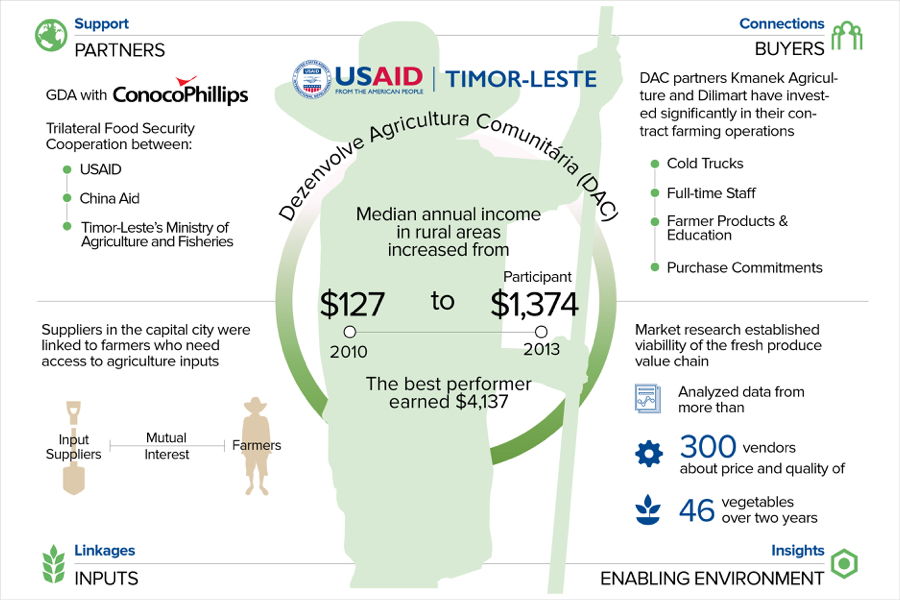DEVELOPMENTS
Is Everyone Really Innovating?
Dec 14, 2014
Innovation seems to be ubiquitous—or, at least, talk about innovation. A 2012 Wall Street Journal review of reports filed with the Securities and Exchange Commission shows companies used some form of the word “innovation” 33,528 times in 2011, a 64 percent increase from five years before. At the same time, one doesn’t have to look hard to find growing cynicism regarding over use of the concept.
Can we really all be innovating all the time?
The DAI Innovation Challenge emerged from a sense of urgency among staff. New technologies are available to DAI and the countries in which we work. Our clients are taking important steps to foster and indeed demand innovation. And, not coincidentally, our peers and counterparts in the development industry are touting their innovation quals.
When we launched the Challenge, we were somewhat unsure of the answer to the question, “are we really innovating?” This is a particularly pointed question for those of us in the development field. Donor-funded projects with explicit scopes of work, strict annual workplans, and carefully defined outputs are not necessarily the most fertile incubators for transformative innovation. Innovation requires experimentation and failure, which are often not possible when a project team is working toward defined objectives under high expectations from the client. Development projects tend to lend themselves more to incremental innovation, where project teams may refine approaches to achieve better outcomes but radical experimentation is something of a luxury.
We received 92 applications from 53 projects in the first phase of the Challenge, far more than expected. Does the healthy response imply that innovation is pervasive across DAI projects? Frankly, no—not all the applications, it turned out, were innovations as we construed the term.
As the judges reviewed the 92 applications their challenge was differentiating between those that highlight significant project accomplishments—laudable and impressive as they might be—and those that present real innovation. Many applications fell into one of three categories:
- Applications of international best practice in a new environment. Many of the submissions showed how introducing new techniques, tested in other parts of the world, could have profound development impacts. The application from the Developing Agricultural Communities (DAC) project in Timor-Leste, for example, highlighted the benefits of introducing contract farming between smallholder farmers and local supermarkets in the capital, Dili. When the farmers joined the project in 2010, the annual median income in rural areas was $127. By 2012, the median income of DAC’s participating farmers had jumped to $900, and by 2013 it had reached $1,374 per year, with the best of more than 400 participating farmers earning $4,137. An impressive accomplishment, no doubt, especially in such a difficult context, but the judges noted that contract farming is a well-tested approach to promoting agricultural development. What they were looking for was an initiative where DAI had come up with something both effective and novel. This is not to denigrate DAC’s achievement but to distinguish between excellent development practice and innovation. And to point out that projects do not have to be “innovative” to have impact.
- Successes that were highly context-specific. The first round of the Challenge attracted several applications describing achievements that did not offer much scope for replication or scaling up. These projects were able to fix localized development problems, but because of the limited scope they did not in the judges’ eyes constitute innovation. The Kyrgyzstan Parliamentary Strengthening Program, for example, created a Kyrgyz–Russian dictionary of legislative terminology that will help to shift legislative drafting from Russian to Kyrgyz, the national language. Without the dictionary, finalized Kyrgyz-language bills can differ in meaning from the original Russian draft, which slows the legislative process. While this tool will likely have a significant impact on law making and the legislative process—not to mention the development of the national language in Kyrgyzstan—it is at heart a subset of the parliamentary strengthening methodology, with a reach limited to its Kyrgyz context.
- Very early stage initiatives. Some first round applicants submitted promising ideas still in their infancy. Absent even initial indications of impact, it was difficult for the judges to assess them. The Kenya Financial Inclusion for Rural Microenterprises project submitted its Credit Factory, which will offer credit customized for particular agriculture value chains, based on farmer needs, production cycles, and repayment capacities, with loans disbursed and collected via mobile phones. All very promising, but the innovation—barely into its pilot—was simply too unproven.
Though applications in these categories are not considered innovations, they are nonetheless valuable to DAI as we seek to improve services to clients and counterparts. And the process certainly proved valuable to the applicant projects themselves, because they were able to share their learning across the company, see what other projects are doing, and make connections that will, as we are already beginning to see, enhance their work.
But this is not to say that innovation is not alive and well at DAI—far from it. Like the ultimate Challenge winner—the Alif Ailaan data platform—the finalists, semi-finalists, and other submissions addressed yet transcended the limited scope of their projects, yielding solutions that are demonstrably effective, demonstrably new, and demonstrably promising in terms of broader reach and potential application. While there is more we can do to foster innovation in development projects, as Betsy Marcotte points out, these examples show it is possible to walk the walk, as well as talk the talk, on development innovation.
